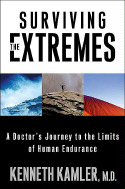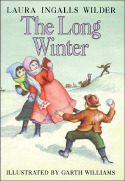 It's 4:30 p.m. and it started snowing a half hour ago. The blizzard is on. This storm has been hyped to the hilt, but we are due to get a minimum of two feet of snow. I picked up Dr. Kenneth Kamler's Surviving the Extremes: A Doctor's Journey to the Limits of Human Endurance at the library yesterday. I think I'll delve into the section where he discusses human exposure to snow and cold--just for fun.
It's 4:30 p.m. and it started snowing a half hour ago. The blizzard is on. This storm has been hyped to the hilt, but we are due to get a minimum of two feet of snow. I picked up Dr. Kenneth Kamler's Surviving the Extremes: A Doctor's Journey to the Limits of Human Endurance at the library yesterday. I think I'll delve into the section where he discusses human exposure to snow and cold--just for fun.
 So the answer to the Laura Ingalls Wilder question. I'm assuming, of course, that everyone has read The Long Winter (and if you haven't, don't miss this classic of American literature. It's as lyrical and fine as any other work considered classic.) In The Children's Blizzard by David Laskin (see the archives to access my post from December 18), he discusses the calamitous winter of 1880-1881 on the northern plains, which was named "The Snow Winter," and is the subject and setting of The Long Winter. The first three-day blizzard hit on October 15 and, after a six-month-long siege of one mega-storm after another, there was still snow on the ground by late May.
So the answer to the Laura Ingalls Wilder question. I'm assuming, of course, that everyone has read The Long Winter (and if you haven't, don't miss this classic of American literature. It's as lyrical and fine as any other work considered classic.) In The Children's Blizzard by David Laskin (see the archives to access my post from December 18), he discusses the calamitous winter of 1880-1881 on the northern plains, which was named "The Snow Winter," and is the subject and setting of The Long Winter. The first three-day blizzard hit on October 15 and, after a six-month-long siege of one mega-storm after another, there was still snow on the ground by late May.
Because the trains could not get through for weeks on end, the Ingalls family survived on wheatberries that the girls hand-ground with a small coffee grinder. It was necessary for the entire family to work from sunup to sundown--either grinding wheat or twisting hay into knots for fuel. Their mother made some sort of pancake with the wheat, without any fat or milk or yeast or leavening agent. UGH. Although Wilder never says so, historians have revealed that the Ingalls were suffering from starvation, as were all of their neighbors in De Smet, South Dakota.
So, in conclusion, then, the Children's Blizzard was in 1888, so is not the same blizzard as any of those described by Laura Ingalls Wilder.

1 Comments:
Judith -
Thanks much for your inclusion here of a classic in American literature. It is so easy for those past the age of majority to assume books written for children are somehow "less" in impact, importance, or worthiness.
I just finished this book last night - the most forlorn on Wilder's children's novels. It's wonderful. As a child, I was afraid of the idea and so had avoided reading it when young yet read the rest of the series. Now, as an adult - and one who recently finished David Laskin's "The Children's Blizzard" - I am enthralled with the same book. While struck by the clarity & sparse narrative of living through seven "moons" of the most severe winter imaginable.
While Wilder's novel takes place during 1880-81, the experience and desolation of the frontier settlers and recent immigrants comes through - in good times and bad. Laskin's nonfiction story inspires as well, with evocative narrative and pacing. And, of course, the same potential sorrow that re-reading "Giants of the Earth" can bring.
Anyway, I enjoyed your blog and description of an important story -for readers of all ages.
Debb Green
Children's Services Coordinator
Iowa City Public Library
debgreen@icpl.org
Post a Comment
<< Home